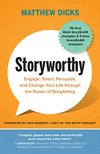Storyworthy: Engage, Teach, Persuade, and Change Your Life through the Power of Storytelling
amazon.com
Saved by Ramon Haindl and
Storyworthy: Engage, Teach, Persuade, and Change Your Life through the Power of Storytelling

Saved by Ramon Haindl and
To review, the strategies for preserving and enhancing surprise in a story: 1.Avoid thesis statements in storytelling. 2.Heighten the contrast between the surprise and the moment just before the surprise. 3.Use stakes to increase surprise. 4.Avoid giving away the surprise in your story by hiding important information that will pay off later
... See moreThis is the trick to telling a big story: it cannot be about anything big. Instead we must find the small, relatable, comprehensible moments in our larger stories. We must find the piece of the story that people can connect to, relate to, and understand. You need to find the story of the man who learns to love children among the man-eating
... See moreIn order to achieve this lofty goal, storytellers must do one thing, and happily for you, it’s exceedingly simple: Always provide a physical location for every moment of your story.
Lie #5: Conflation Storytellers use conflation to push all the emotion of an event into a single time frame, because stories are more entertaining this way. Rather than describing change over a long period, we compress all the intellectual and emotional transformation into a smaller bit of time, because this is what audiences expect from stories.
Lie #4: Progression A lie of progression is when a storyteller changes the order of events in a story to make it more emotionally satisfying or comprehensible to the listener. In my experience, this is the least common lie told, and I have never done it myself, but I’ve recommended that other storytellers use it from time to time.
Lie #3: Assumption Storytellers use assumption when there is a detail so important to the story that it must be stated with specificity, so the storyteller makes a reasonable assumption about what the specifics may be. This does not mean that a storyteller should assume all details. It is only when the forgotten detail is critical to the story that
... See moreLie #2: Compression Compression is used when storytellers want to push time and space together in order to make the story easier to comprehend, visualize, and tell. If the first scene of your story takes place on a Monday, for example, and the next scene happens on Friday, and you are concerned about the audience wondering about Tuesday, Wednesday,
... See moreFive Permissible Lies of Storytelling Lie #1: Omission Every story contains omissions. If you were to tell every single thing in the story, it would never end. We all omit elements from our stories, but great storytellers do this strategically and for a variety of reasons.
A Crystal Ball is a false prediction made by a storyteller to cause the audience to wonder if the prediction will prove to be true. In “Charity Thief,” I say: [The man] points his finger at me and says, “You stay right there.” Then he walks back into his house, and I know what he’s doing. He’s calling the police, and they will come and arrest me
... See more